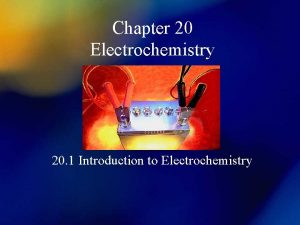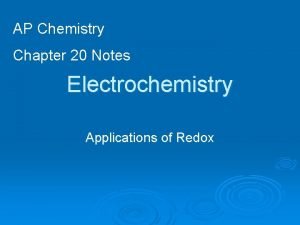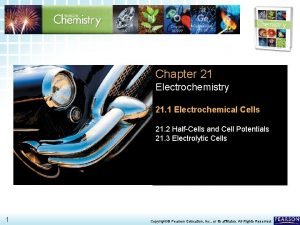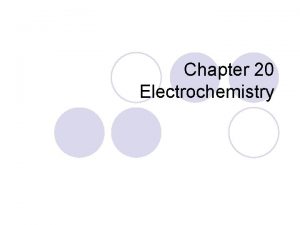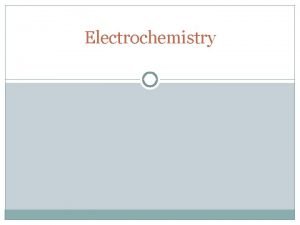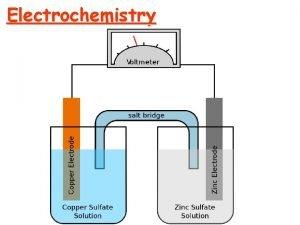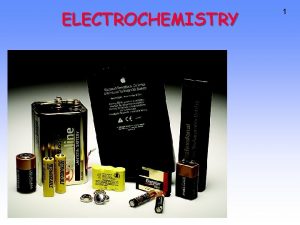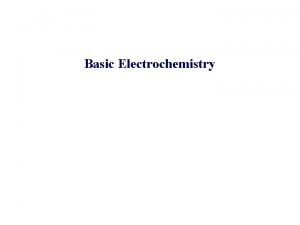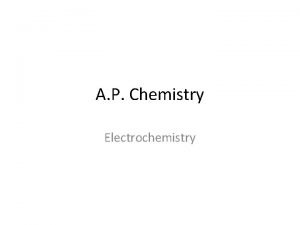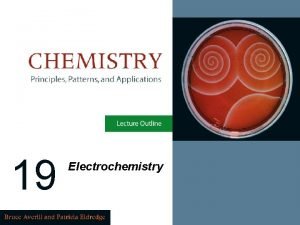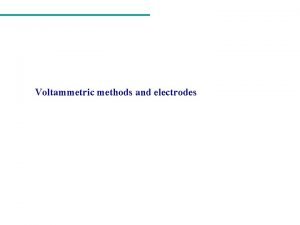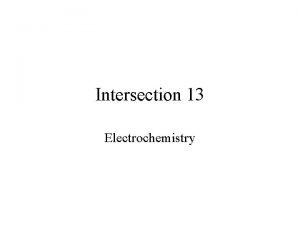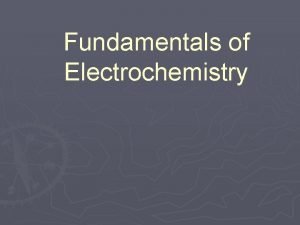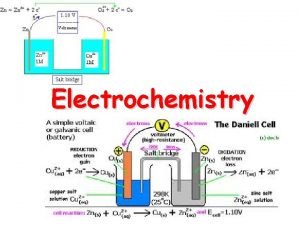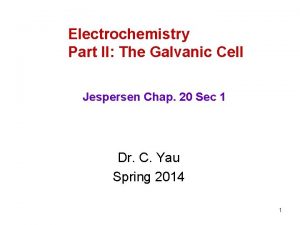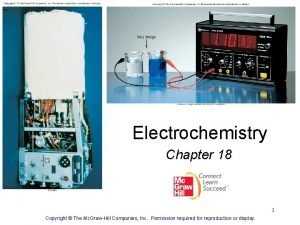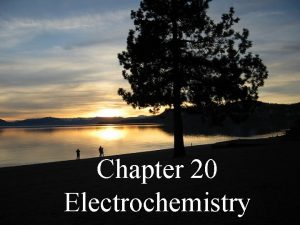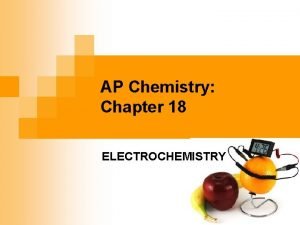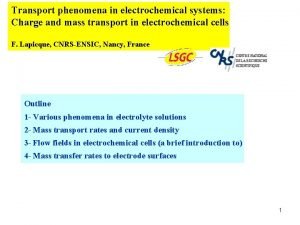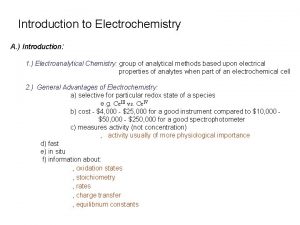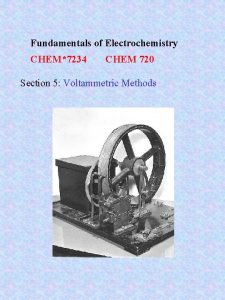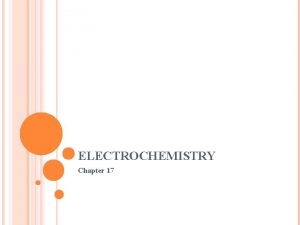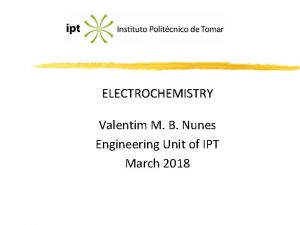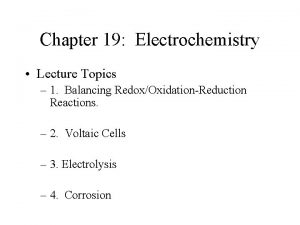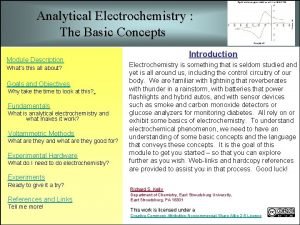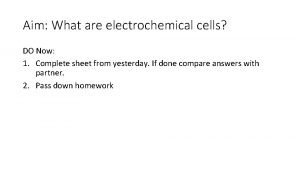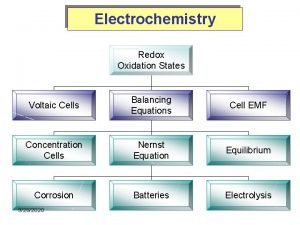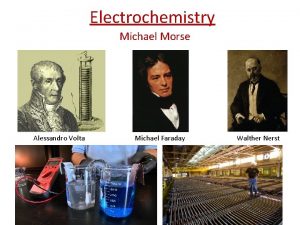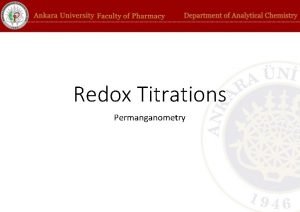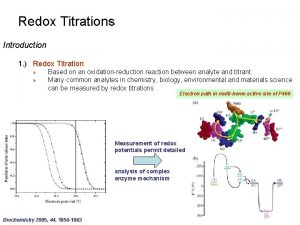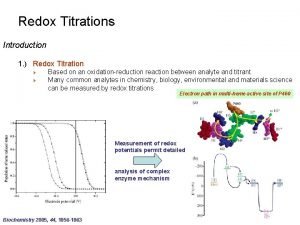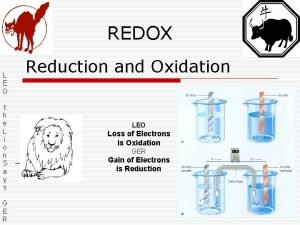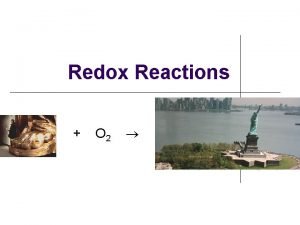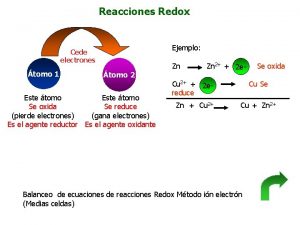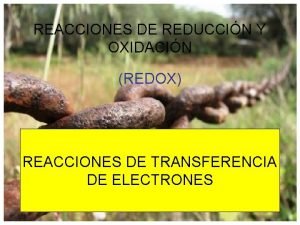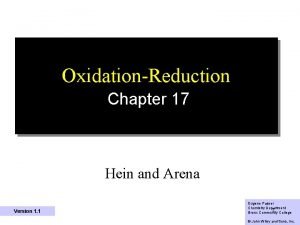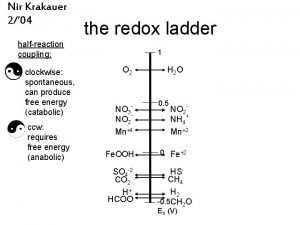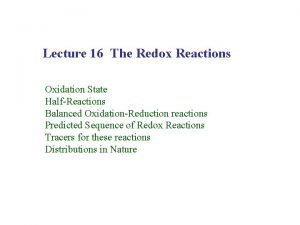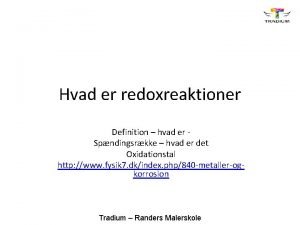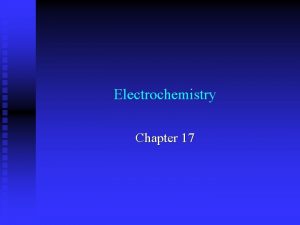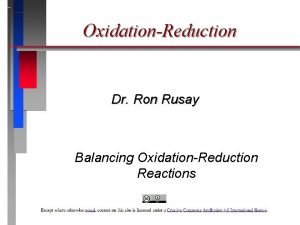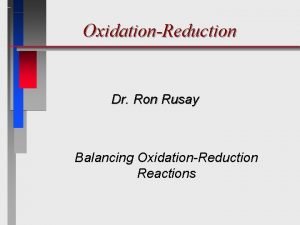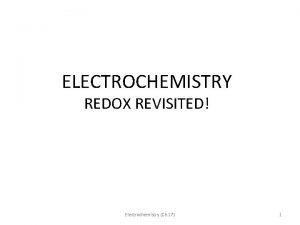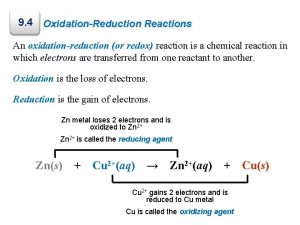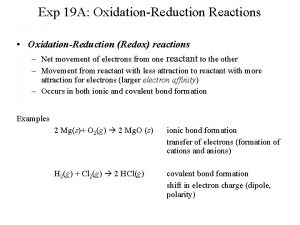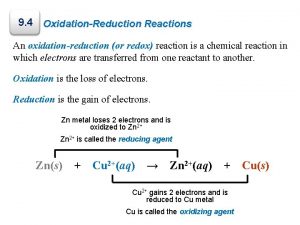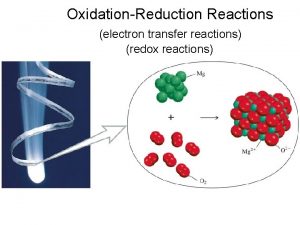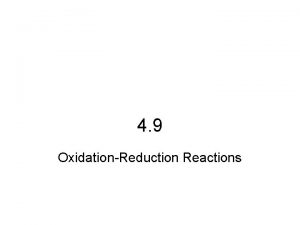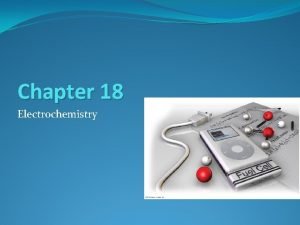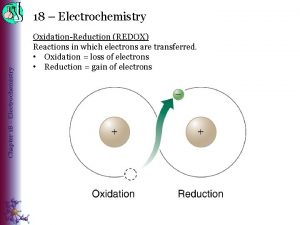Electrochemistry Chapter 21 Electrochemistry and Redox Oxidationreduction Redox






































































- Slides: 70

Electrochemistry Chapter 21

Electrochemistry and Redox Oxidation-reduction: “Redox” Electrochemistry: study of the interchange between chemical change and electrical work Electrochemical cells: systems utilizing a redox reaction to produce or use electrical energy

Redox Review Redox reactions: electron transfer processes Oxidation: Reduction: loss of 1 or more egain of 1 or more e- Oxidation numbers: imaginary charges (Balancing redox reactions)

Oxidation Numbers (O. N. ) 1. Pure element O. N. is zero 2. Monatomic ion O. N. is charge 3. Neutral compound: sum of O. N. is zero Polyatomic ion: sum of O. N. is ion’s charge *Negative O. N. generally assigned to more electronegative element

Oxidation Numbers (O. N. ) 4. Hydrogen assigned +1 (metal hydrides, -1) 5. Oxygen assigned -2 (peroxides, -1; OF 2, +2) 6. Fluorine always -1

Oxidation-reduction Oxidation is loss of e. O. N. increases (more positive) Reduction is gain of e. O. N. decreases (more negative) Oxidation involves loss Reduction involves gain OIL RIG

Redox Oxidation is loss of ecauses reduction “reducing agent” Reduction is gain of ecauses oxidation “oxidizing agent”


Balancing Redox Reactions 1. Write separate equations (half-reactions) for oxidation and reduction 2. For each half-reaction a. Balance elements involved in e- transfer b. Balance number e- lost and gained 3. To balance emultiply each half-reaction by whole numbers

Balancing Redox Reactions: Acidic 4. Add half-reactions/cancel like terms (e-) 5. Acidic conditions: Balance oxygen using H 2 O Balance hydrogen using H+ Basic conditions: Balance oxygen using OHBalance hydrogen using H 2 O 6. Check that all atoms and charges balance

Examples Acidic conditions: Basic conditions:

Types of cells Voltaic (galvanic) cells: a spontaneous reaction generates electrical energy Electrolytic cells: absorb free energy from an electrical source to drive a nonspontaneous reaction

Common Components Electrodes: conduct electricity between cell and surroundings Electrolyte: mixture of ions involved in reaction or carrying charge Salt bridge: completes circuit (provides charge balance)

Electrodes Anode: Oxidation occurs at the anode Cathode: Reduction occurs at the cathode Active electrodes: participate in redox Inactive: sites of ox. and red.

Voltaic (Galvanic) Cells A device in which chemical energy is changed to electrical energy. Uses a spontaneous reaction.

Oxidation Reduction




Zn 2+(aq) + Cu(s) Cu 2+(aq) + Zn(s) Zn gives up electrons to Cu — “pushes harder” on e— greater potential energy — greater “electrical potential” Spontaneous reaction due to — relative difference in metals’ abilities to give e — ability of e- to flow

Cell Potential / Electromotive Force (EMF): The “pull” or driving force on electrons Measured voltage (potential difference)

Ecell = +1. 10 V

Cell Potential, E 0 cell potential under standard conditions elements in standard states (298 K) solutions: 1 M gases: 1 atm


Standard Reduction Potentials E 0 values for reduction half-reactions with solutes at 1 M and gases at 1 atm Cu 2+ + 2 e Cu E 0 = 0. 34 V vs. SHE SO 42 + 4 H+ + 2 e H 2 SO 3 + H 2 O E 0 = 0. 20 V vs. SHE






E 0 cell and DG 0 E 0 cell > 0 D G 0 < 0 Spontaneous E 0 cell < 0 D G 0 > 0 Not E 0 cell = 0 D G 0 = 0 Equilibrium

Calculating E 0 cell = E 0 cathode - E 0 anode Br 2(aq)+2 V 3+ +2 H 2 O(l) 2 VO 2+(aq)+ 4 H+(aq)+ 2 Br-(aq) Given: E 0 cell = +1. 39 V E 0 Br 2 = +1. 07 V What is E 0 V 3+ and is the reaction spontaneous?

E 0 values More positive: Stronger oxidizing agent More readily accepts e. More negative: Stronger reducing agent More readily gives e. Stronger R. A. + O. A. Weaker R. A. + O. A.

Free Energy and Cell Potential n: F: number of moles of e. Faraday’s constant 96485 C mol of e-

DG 0, E 0, and K At equilibrium: At 298 K: DG 0 = 0 and K = Q


Nernst Equation Under nonstandard conditions


Concentration Cells. . . a cell in which both compartments have the same components but at different concentrations






Batteries A battery is a galvanic cell or, more commonly, a group of galvanic cells connected in series.








Fuel Cells Galvanic cells Reactants are continuously supplied. 2 H 2(g) + O 2(g) 2 H 2 O(l) anode: cathode: 2 H 2 + 4 OH 4 H 2 O + 4 e 4 e + O 2 + 2 H 2 O 4 OH



Corrosion Some metals, such as copper, gold, silver and platinum, are relatively difficult to oxidize. These are often called noble metals.




Electrolysis Forcing a current through a cell to produce a chemical change for which the cell potential is negative.






Stoichiometry How much chemical change occurs with the flow of a given current for a specified time? current and time quantity of charge moles of electrons moles of analyte grams of analyte




 Ap chemistry chapter 18 electrochemistry test
Ap chemistry chapter 18 electrochemistry test Introduction to electrochemistry
Introduction to electrochemistry Ap chem electrochemistry review
Ap chem electrochemistry review Cell chapter 21
Cell chapter 21 Galvanic vs electrolytic cell
Galvanic vs electrolytic cell Electrons flow from anode to cathode
Electrons flow from anode to cathode Oxidation reduction reactions chapter 19 review
Oxidation reduction reactions chapter 19 review Chapter 20 worksheet: redox answers
Chapter 20 worksheet: redox answers Chapter 20 worksheet redox
Chapter 20 worksheet redox Faradays contant
Faradays contant Transport number
Transport number Electrochemistry tutorial
Electrochemistry tutorial Oxidation and reduction in galvanic cells
Oxidation and reduction in galvanic cells What is electrochemistry?
What is electrochemistry? Electrochemistry balancing equations
Electrochemistry balancing equations Electrochemistry stoichiometry
Electrochemistry stoichiometry Khan academy electrolysis
Khan academy electrolysis Ir drop
Ir drop Balancing redox reactions
Balancing redox reactions Ap chemistry electrochemistry
Ap chemistry electrochemistry Oxidation and reduction in galvanic cells
Oxidation and reduction in galvanic cells Equilibrium constant formula electrochemistry
Equilibrium constant formula electrochemistry Electroanalytical techniques
Electroanalytical techniques Electrolysis table
Electrolysis table Fundamentals of electrochemistry
Fundamentals of electrochemistry What is electrochemistry
What is electrochemistry What is electrochemistry in chemistry
What is electrochemistry in chemistry Kno3 salt bridge
Kno3 salt bridge Diagonal rule electrochemistry
Diagonal rule electrochemistry What is polarization in electrochemistry
What is polarization in electrochemistry Electrochemistry lesson plan
Electrochemistry lesson plan Branches of electrochemistry
Branches of electrochemistry Oxidation reduction memory tricks
Oxidation reduction memory tricks Mass transport electrochemistry
Mass transport electrochemistry Introduction to electroanalytical methods
Introduction to electroanalytical methods Fundamentals of electrochemistry
Fundamentals of electrochemistry Electrochemistry
Electrochemistry Diagonal rule electrochemistry
Diagonal rule electrochemistry Ir drop in electrochemistry
Ir drop in electrochemistry Electrochemistry balancing equations
Electrochemistry balancing equations Whats electrochemistry
Whats electrochemistry Red cat electrochemistry
Red cat electrochemistry Zn cu
Zn cu Electrochemistry balancing equations calculator
Electrochemistry balancing equations calculator Electrochemistry
Electrochemistry Cellular respiration redox
Cellular respiration redox Redox rules
Redox rules Topic 19
Topic 19 Hall heroult process
Hall heroult process Kmn=4
Kmn=4 Redox titration introduction
Redox titration introduction Introduction of redox titration
Introduction of redox titration Redox rules
Redox rules Leo ger oil rig
Leo ger oil rig Couple redox reaction
Couple redox reaction Oxidation number
Oxidation number In a redox reaction, electrons are transferred
In a redox reaction, electrons are transferred Oxidation umber
Oxidation umber Combining half equations
Combining half equations Single replacement redox reaction
Single replacement redox reaction Reactions that produce gas
Reactions that produce gas Semirreacciones redox ejemplos
Semirreacciones redox ejemplos Reduccin
Reduccin Wanadowe akumulatory przepływowe
Wanadowe akumulatory przepływowe Leo ger example
Leo ger example Sulfuric acid redox reaction
Sulfuric acid redox reaction Redox reactions examples
Redox reactions examples Half equations redox
Half equations redox Nir krakauer
Nir krakauer Z scheme of photosynthesis diagram
Z scheme of photosynthesis diagram Redoxreaktion eksempel
Redoxreaktion eksempel

